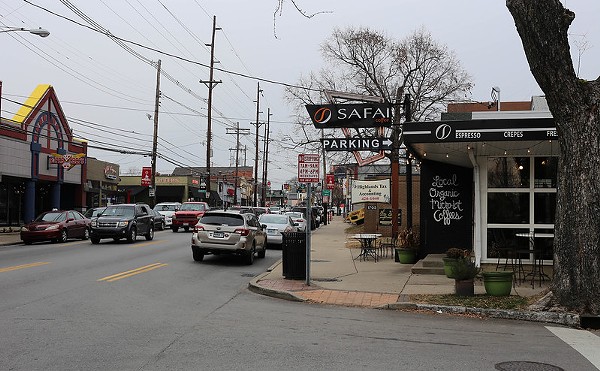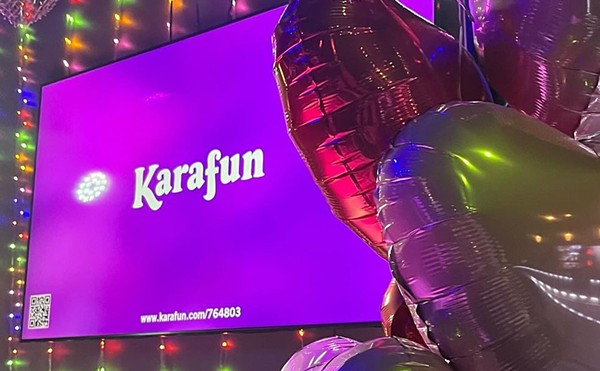
Meanwhile, it’s freezing cold in here — 57 degrees by the thermostat next to the refreshment stand — and many of the women, sniffles and rosacea kicking in naturally, are complaining about the adverse effects the seasonal cold has on muscles and joints, things used virtually every second of these practices, the seedlings of Louisville’s first official roller derby league.

The three, who didn’t know one another before this thing got rolling, interact more like sisters than tiptoeing new friends; now they’re penning number ratings next to the rollergirl’s names — Deadleigh, Sweet Mama, Envy Miyoni and Biddy the Bomber (the women always use their derby names) — as each performs a series of predetermined exercises meant to judge overall aptitude to play this sport. This group of four, the first to be assessed, betrays the real chasm of ability in the league. Each has a pretty similar set of skills: She can skate quickly around the track, which is delineated by a rope taped to the floor to hold center court and the small orange cones marking the outer boundary; she can handle both light and harder checking, of paramount importance in such a physical contest; she can jump on her skates, perform “whips” — where two women clasp hands and the one in front whips the other forward, generating impressive speed — she can skate on one foot, and she can stop quickly, by either turning one skate perpendicular or utilizing that essential toe stopper.
“God, I wish I could tell them what they’re doing wrong,” Ahlrich says, her voice loud but seeming perpetually masked by the huskiness of a three-day cold. Playing spectator, or judge in this case, isn’t a comfortable role for Ahlrich, who likes to be immersed in the action while maintaining the nonnegotiable air of leader.

It’s hard to rectify these divisions in the classic sports-team sense, because traditional sense it does not make. Sometimes girls get pissed with it and quit. Sometimes they talk under their breath about Speth, the coach, definitely the most intense one, or some of the others who make up the league’s nine-member Board of Directors. There is a reason the concept of player-coach has been largely unsuccessful in the history of professional sport, but these women — attitudes in hand and front of mouth — seem to be succeeding.
“It’s been rocky, especially for me,” Ahlrich says. Two weeks ago, there was a league meeting where the board members elucidated their roles to the entire body of women. There had been complaints about the level of intensity; some women felt like they were paying to be barked at.
“You’ve got 30-some women,” says Jessica “Sweet Mama” Dawkins. “Getting them all in the same room and being copacetic twice a week is difficult.”

But tonight’s tryouts are the apex of this friend-as-boss dichotomy, and the tension here is more palpable than that collected over the previous several months, when they’ve worked as a group to learn the basic techniques that will ensure they don’t travel to Knoxville, Indianapolis or some other regional home to roller derby and get drubbed.
Fad fades to sound sport
There wasn’t much to do in America, socially, during and immediately after the Great Depression. That’s partly why, around 1935, a promoter named Leo Seltzer founded the Transcontinental Roller Derby, which brought a dash of competition to the emerging roller-skating fad. In essence, the TRD was a simulated cross-country race with 25 teams of two zipping around a track several thousand times. The thing lasted a month, took place in Chicago and covered something like 3,000 miles.
Roller derby was never again quite that ridiculous.
In fact, it wasn’t long before Seltzer, on the advice of others who felt roller derby needed a shot of adrenaline, shrank the track and packed more skaters onto it. The theory was to create physical confrontations to up viewership. And gullible we were, the American audience.
In the early ’60s, a rival to Seltzer’s roller derby mint came forth as Roller Games, a considerably more theatrical, less serious version of the sport that would siphon fans and ultimately lead to the brand of roller derby most recognizable to today’s mainstream. Bouts were often staged, as were fights and injuries; Roller Games was to Seltzer’s roller derby what WWE is to Greco-Roman.
If you go now to YouTube.com and search for roller derby, much of what you will find is this version. It figured prominently into ’70s and early ’80s pseudo-entertainment, was unisex and remains just about as low-brained as the WWE. But it’s fun to watch, and people are in large part fun-hogs, which has been the Achilles’ Heel of the serious-minded for all of human history.

There are positions — typically one jammer, one pivot and three blockers — and the teams move in packs, each trying to advance its jammer past as many of the opposing team’s skaters as possible. That’s how points are scored. The two-minute “jams” fill out a three-period bout, with each period lasting 20 minutes, which is to say you’d better be in shape to do this.
Roller resurgence
What we have now in America amounts to a citizens’ movement of sport. It exists as part of underground culture and has close ties to the punk rock world, in particular the feminist Riot Grrl movement, both in general appearance and attitude. Sparked in 2000 by the Texas Rollergirls in Austin, roller derby has become official: There are 30 leagues under the WFTDA banner; it’s estimated that around 150 are operating in the United States, including regional outfits in Nashville, Knoxville, Ft. Wayne and Indianapolis. There are four leagues in Kentucky, which will compete against each other: the Mason-Dixon Rollergirls (Richmond), Black-n-Bluegrass Rollergirls (Covington), Kentucky Roller Derby (Lexington), and the Derby City Rollergirls.
It is a tried-and-true revival, and its popularity is attributable, in some part, to nostalgia — many of the women involved grew up during a boom period for roller-skating in the ’70s and ’80s.
“It was such a big part of our lives, and we loved it so much,” Brown wrote in an e-mail last week. At 31, the married mother of two who restores historic homes for a living is right around the middle of the age range for the Derby City Rollergirls, which is something like 21 to 43 on a given night. She, like Speth and Ahlrich, spends as many as 15 hours a week working behind the scenes for the league. As each member of the board has a specific job, hers is to arrange bouts and recruit and manage referees. “Roller-skating has died somewhat. And a chance to revive it hits home with a lot of women. A chance to get back in my skates again is not one I’m going to pass by.”
Amber Martin is a former Louisvillian who started the Naptown Rollergirls, the Indianapolis league, in February. She said the popularity is linked to the void left when Riot Grrl — a feminist movement largely based in underground punk music — died out.
“Any girl can strap on a pair of skates and start learning how to skate,” Martin said, careful not to downplay the sport’s intensity. “It’s a little easier than picking up a guitar, I think.”
The appeal is in the camaraderie, athleticism and competition, Martin continued, which all tie into a feminist ideal. Every one of the Louisville rollergirls I talked to said virtually the same thing. It’s a nontraditional exercise in female bonding that mirrors what males have done exclusively for decades. Women pouring sweat, scantily clad and pursuing a very physical sport challenges the status quo, and that is just plain awesome.
“I really think that the important twist

Brown, like most of the women in the league, is quick to point out that when you talk about perceptions of roller derby and the performance art that has been its public face until only a few years ago, there is both athleticism and dignity in what they do. The bruises are real and the roller derby revival has remained an underground phenomenon mostly because people misunderstand it. To be sure, this is a sport about scoring points, not getting in fights. That is not to say, however, that roller derby isn’t physical. It is both, which helps illuminate the path to its 21st-century revival.
“We now strive to be athletes playing a demanding sport who occasionally exhibit ‘unsportswoman-like conduct’ rather than a show of pre-planned confrontations that are centered around an arena,” Tinkerhell wrote in the same e-mail. “What used to be simply entertainment is now sport.”
Revival hits Louisville
When Ahlrich and Dawkins — best friends who grew up together, figuratively speaking, in one of the two skating rinks of Lafayette, Ind. — drove to Austin almost two years ago to attend the South By Southwest music festival, they came across a wild-looking tour bus packed to the gills with women in various stages of tattoo and dress.
“I was floored by the fact that they even had a tour bus,” Ahlrich said of the Texas Rollergirls, over a late dinner and drinks at Ramsi’s last week. The 28-year-old, a stylist at Hair Strobel who smokes Camel Lights and prefers bourbon, goes by the name Bad Penny in roller derby circles. She started skating three-quarters of her life ago, at the nimble age of 7, to get her fitness badge as a Girl Scout. Now she has annual skating parties to celebrate her birthday.
Ahlrich told me that the thing most shocking that day in Texas was a sudden realization that roller derby works as a business. Thus, the ride back from Austin to Louisville, about a 16-hour haul, provided the perfect vacuum for the pair to cogitate on the underpinnings of a Louisville league. Ahlrich began researching as soon as she got back to her apartment, which in a little more than a year would become the working headquarters of the Derby City Rollergirls.
But it wouldn’t come easy, or without a lot of help. “I found all these great, amazing women to help me do it,” Ahlrich said.
The abridged version is this: Ahlrich and two women, Kelly “VaVa Kaboom” Lutz and Annie “Assphalt Annie” Harlow, formed Derby City Roller Girls LLC with seed money and legal assistance from Debbie Rosenstein, who skated briefly but was injured and has since quit. Through mostly word of mouth, they amassed a roster of 33 women, each of whom pay $30 a month in league dues, as well as a $35 annual premium for insurance. There are a handful of referees as well, a near-equal balance of men and women, who will officiate when bouts begin in May.
“It’s fascinating to me, the girls who just come out of their shells,” Speth said. Speth — Sk8 Ninja, the hardass of the group, a 27-year-old stylist at Salon and Boutique Bacco who grew up skating in New Orleans and has tattoos over much of the parts of her upper body not covered by her DCRG A-shirt — is probably in the best position to judge. She’s the coach, always the one with the whistle, a fast skater with a relaxed capability for sharp movements and the graceful agility to stay on her feet when she gets checked, something that becomes a priority the first time one of these women falls and winds up with an ass bruise the size of a honeydew. Speth runs the practices like a high-school football coach.
The payoff
The collective effort behind and inside the Derby City Rollergirls is about to pay its first dividend. Almost five months of chest-pounding, sweat-drenched practices and enough bruises and scrapes and cuts and strawberries to prove abuse to any jury, the league divides itself into two teams this Friday, during a party-cum-fundraiser at the Monkey Wrench (see box). The teams begin scrimmages, which will be open to the public, on Feb. 22. They’re not sure where yet — Greentree Skateland doesn’t have bleachers. Louisville Gardens, Broadbent Arena and the Convention Center top the wish list.
After they finish their first round of assessments, the four women break off outside the rink and chug from little paper cups of water. Lanie Hopping, or Envy Miyoni, is panting, and her cheeks are brick red. She stands a little over 6 feet on her skates.
“Our skills have come so far just in the short time we’ve had trainers running practice,” she tells me. She was part of the group who drove to Knoxville last month to watch a bout in the Hard Knox Rollergirls league. There, among other things illuminating the experience to which each is now committed, they saw a woman break her leg on the track. The Derby City Rollergirls, who hope to bout with most of the leagues in the region, took one thing over many away from it, what Speth told the group during a league meeting that kicked off the first practice I watched, just over five weeks ago:
You’d better be ready for this.
Contact the writer at
[email protected]





